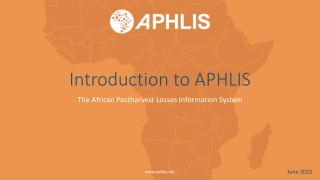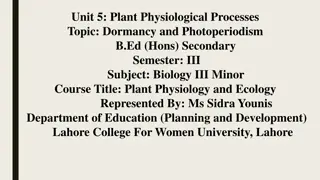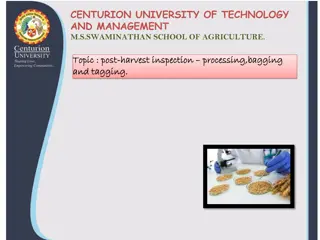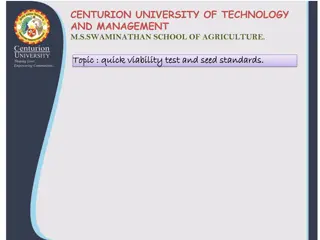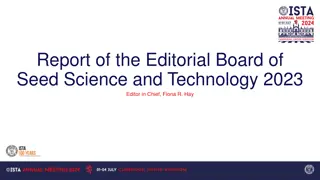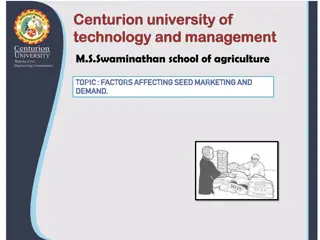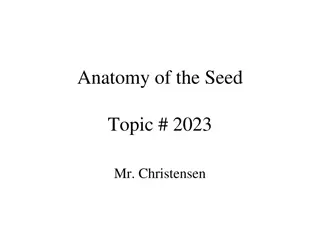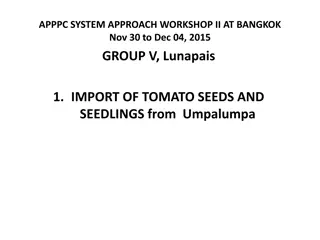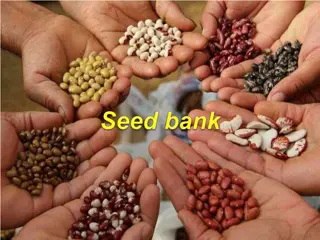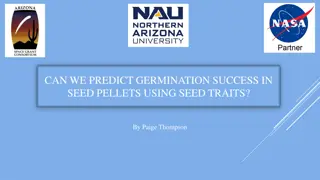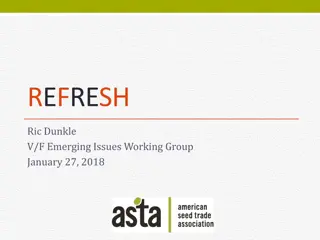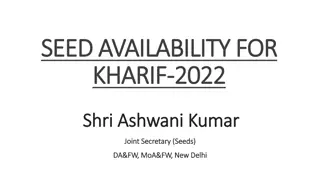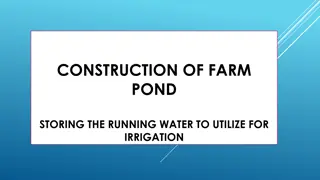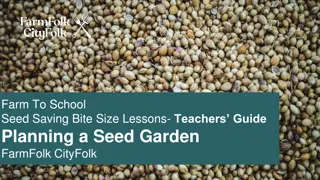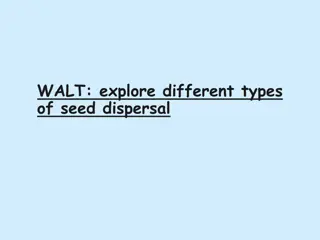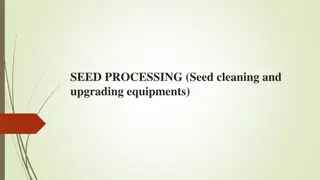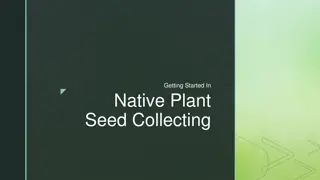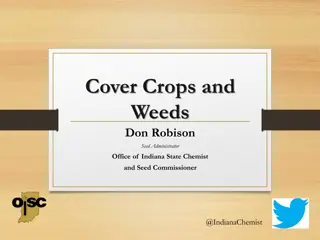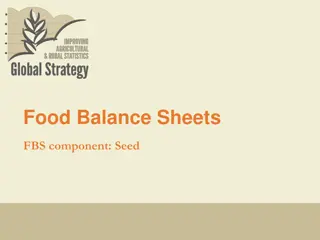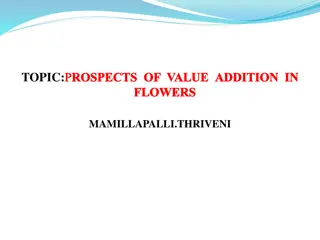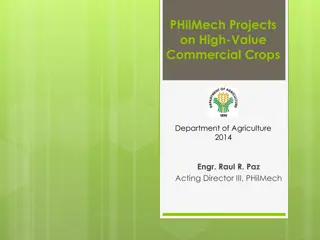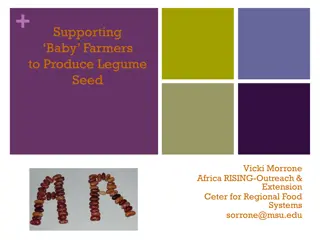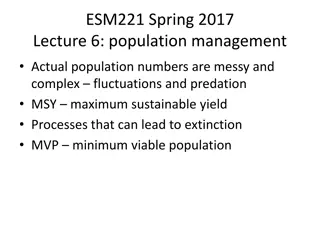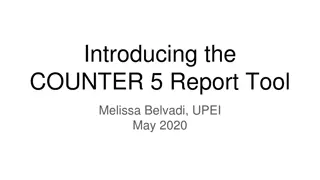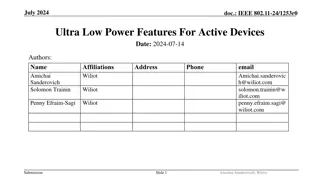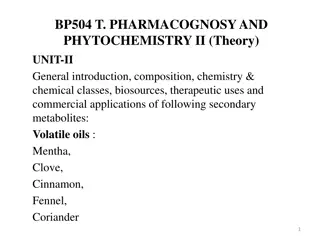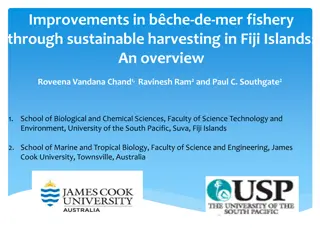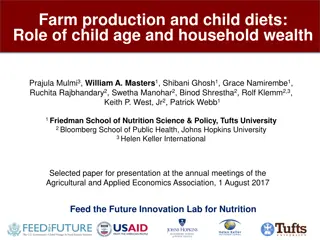Harvesting and Postharvest Techniques for Quality Seed Production
Understand the importance of harvesting crops at the right timing to maximize seed quality. Learn about half-matured and full-matured stages, postharvest ripening, and indicators for precise timing. Discover the significance of counting days from flowering/pollination for determining harvest timing. Explore how postharvest ripening can enhance seed maturity and reduce plant stress, along with methods for ripening fruits after harvesting.
Download Presentation

Please find below an Image/Link to download the presentation.
The content on the website is provided AS IS for your information and personal use only. It may not be sold, licensed, or shared on other websites without obtaining consent from the author. Download presentation by click this link. If you encounter any issues during the download, it is possible that the publisher has removed the file from their server.
E N D
Presentation Transcript
1 Harvest GVSPP Q17
2 Harvest Harvest the crops at the right timing Half-matured (brinjal, cucumber, pumpkin, etc.) Postharvest ripening Seed extraction Full-matured (tomato, okra, capsicum, bitter gourd, Luffa, etc.) Seed extraction Colour Size Texture Dryness Days from flowering/pollination DO NOT harvest from Virus or Bacteria infected Plants
2 Harvest Crops should be harvested at the right timing to maximize the quality of harvested seeds Some crops can be harvested at half-matured stage to fully mature by postharvest ripening The indications of harvesting timing can be recognized by colour, size, texture, and dryness (cracking) To know more precise harvesting timing, days from flowering or pollination date can be used Plants that infected by virus and bacteria should not be harvested pathogens in high possibility translocated to the seeds
3 Harvest Determination of harvesting timing by counting days Count the days from the date of flowering/pollination Record flowering/pollination date Indications of harvesting timing Postharvest ripening Postharvest ripening Crop Days to harvest Crop Days to harvest Tomato Around 45 days Not necessary Pumpkin 40 - 60days Around 20days Brinjal Around 50days 10 20days B. gourd Around 30days Not necessary Capsicum 60 70days Not necessary Luffa 50 60days Not necessary Cucumber 30 40days 3 10days W. melon 30 40days 4 5days
3 Harvest Determine the harvesting timing by counting days from flowering/pollination Record the date of flowering/pollination Considering flowering/pollination date as the day 1, following day is the day 2, and so on When counting days reach to the indicated days for the particular crops (showed in table), crops are at the right timing to harvest
4 Postharvest GVSPP Q18-Q21
5 Postharvest Ripening Some crops can be harvested before full-mature, and let the fruits fully matured after harvesting Advantage of postharvest ripening Improve seed maturity Decrease plant stress Distribute more nutrients to other fruits Minimize the risk of damaging fruits in field Method of postharvest ripening Store the fruits in well-ventilated and shady place for days after harvesting
5 Postharvest Ripening For the particular crops that can apply postharvest ripening, it is recommended to practice because; Seed maturity is increased to improve quality Lesser number of fruits gives less stress to the plant. Reducing plant stress as much as possible is important for the plant to stay healthily and vigorously By reducing the number of fruit from the plant, other remained fruits can get more nutrients to improve fruit/seed quality Risks of damaging fruits (by disease, pest, wild animals, or natural disaster) increase as the fruits stay in field for longer period. Earlier harvest helps reducing the risks of damaging the fruits After harvesting, the fruits should be stored in well- ventilated and shady place for several days. Postharvest ripening period varies in crops
6 Effect of Postharvest Ripening Germination Rate with different harvest and postharvest ripening days Brinjal Source: Suzuki (1964) Days of postharvest ripening Harvesting days after flowering 0 5 10 15 20 34.0% 58.8% 99.8% 97.0% 99.5% 50 96.2% 95.3% 99.9% 60 99.5% 70 Cucumber Harvesting days after flowering Source: TBIC (2012) Days of postharvest ripening 0 10 20 10.0% 67.5% 76.8% 20 92.5% 95.0% 100% 30 97.5% 95.0% 85% 40
6 Effect of Postharvest Ripening Data in the tables is results of studies on postharvest ripening on brinjal and cucumber The results show that there is no difference in seed germination between harvested at fully matured stage and earlier harvested and compensate days by postharvest ripening Brinjal: Germination rate of Fully matured (harvested at 70days) brinjal = 99.5% Harvested at 50days and having postharvest ripening for 20days =99.5% (50+20=70days) Harvested at 60days and having postharvest ripening for 10days =99.9% (60+10=70days) By practicing postharvest ripening, fruits can be harvested not until waiting for fully matured in field without having seed germination problem
7 Seed Extraction Seeds should be extracted properly not to damage the seeds Some crops require washing with water for seed extraction (tomato, brinjal, cucumber, etc.). But do not wash the crops not requiring washing (Capsicum, Luffa, Okra, etc.)
7 Seed Extraction Handle with care not to damage the seeds when extract the seed from fruits Some crops need fermentation period (tomato, cucumber), some crops need water to extract seeds(brinjal), and some crops need to wash with water to clean the seeds (bitter gourd, snake gourd) when extracted. Such crops are okay to use water but avoid using for the crops that unnecessary to wash (capsicum, okra, luffa) Seeds to contacting water may decrease seed germination or degrade seed appearance See the technical manual for seed extraction methods for each crop
8 Drying Drying of seed is a very important procedure that influencing the seed quality greatly Seed has to be dried as soon as it can to prevent decreasing seed germination How? 1. Spread seeds evenly on a mat under the sun to dry moisture from seed surface 2. Avoid exposing seeds under direct sunlight when irradiation is too strong(11am-2pm) 3. Turn over seeds constantly to dry uniformly 4. After drying seed surface, further dry them in shade (dry in well-ventilated place. Avoid high temperature and humidity place)
8 Drying Drying of seed is a very important procedure that influencing the seed quality greatly Seed has to be dried as soon as it can to prevent decreasing seed germination How? 1. Spread seeds evenly on a mat under the sun to dry moisture from seed surface 2. Avoid exposing seeds under direct sunlight when irradiation is too strong(11am-2pm) 3. Turn over seeds constantly to dry uniformly 4. After drying seed surface, further dry them in shade (dry in well-ventilated place. Avoid high temperature and humidity place)
9 Drying Dry wet seeds as soon as possible Spread seeds evenly. Try not seeds lie on top of each other Do not dry seeds directly on concrete or on soil Place seeds on a mat to buffer heat from bottom Better to dry seeds apart from the ground Turn over seeds to dry uniformly
9 Drying Dry wet seed as soon as possible not to seed to absorb water Seeds should be spread evenly. If seeds lie on top of the each other, seeds cannot be dried uniformly Avoid drying seeds directly on concrete. Seeds are heated up from the bottom as concrete heated up by sunlight. Place a mat or something between seeds and ground to buffer heat up the seeds It is better to place seeds at higher place from the ground where heat from the bottom can be buffered
10 Cleaning Cleaning is to remove dust from the seeds Improve physical seed appearance Prevent seeds to absorb moisture How? Winnowing Sieving Washing with water
10 Cleaning Cleaning is to remove dust attach to the seeds By doing seed cleaning, it improves seed physical appearance to help increasing commercial value Moisture is a great enemy to seeds to maintain seed quality. Dust attach to the seeds helps absorbing moisture in air to increase seed moisture. Seeds without dust absorbs less moisture from air Winnowing, sieving, washing are the ways to clean the seeds
11 Storing Avoid storing seeds in a high humidity and temperature condition Germination rate of tomato seeds at 372days after storing under different conditions Relative Humidity (RH) 5 10 Source: Barton (1941) Air Temperature 20 30 35% 94% 91% 90% 91% 55% 90% 89% 89% 83% 76% 88% 76% 45% 0%
11 Storing Seeds should be stored in low humidity and low temperature condition Humidity and temperature influence the quality of seeds, especially seed germination As it s shown in the table, tomato seeds that stored under low humidity and low temperature have high germination rate even after storing for a year On the other hand, tomato seeds that stored under high humidity and high temperature performed worst in germination
12 Storing Pile seed bags on wooden pallet or shelf Pile seed bags keeping distance from the ground and wall as much as possible Bagging Material: Jute/fabric bag highly prevents seeds from moisture Double layer plastic bag prevents more moisture than single layer plastic bag
12 Storing Avoid piling seed bags directly on the ground (floor). Seed bags should be piled on wooden pallet or shelf to prevent moisture to percolate from the ground Due to the temperature gap between day and night, walls of a building sometimes get wet by dew condensation. Direct contact of seed bags to the walls should be avoided Seeds should be stored in bags. Jute/fabric bag prevents seeds from moisture to a large degree If a plastic bag is used for bagging, better to make it double layer to protect seed from moisture Older seeds cause seed quality to deteriorate quicker than fresher seeds. The old seeds should be discarded and renewed the seed stock periodically


